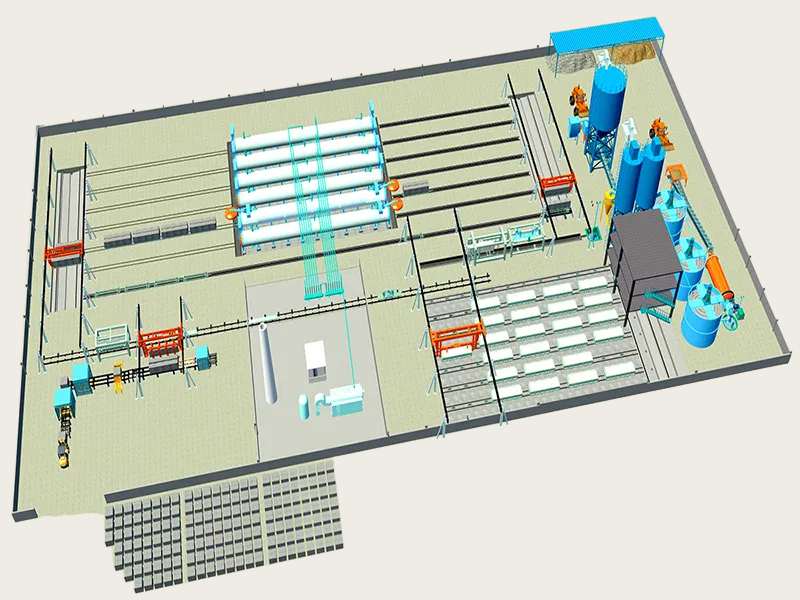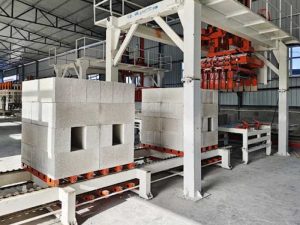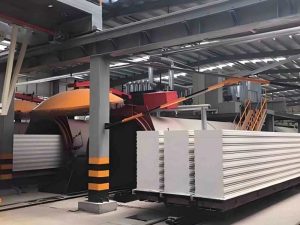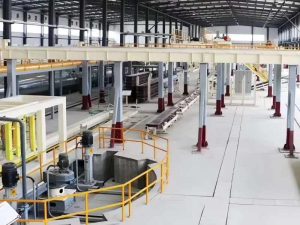Fully Automatic 300,000m3/Year AAC Block Plant Hot Sale
The 300,000 m3/Year AAC Block Plant is a large-scale production line, used in manufacturing Autoclaved Aerated Concrete (AAC) blocks, with an annual output of 300,000 m³.
As the brand manufacturer of AAC plant, we can supply customized solution based on your specific demands.
The production process includes mixing and casting, curing and gasification, cutting and forming, autoclave curing, etc.
The high-capacity 300,000m3/Year AAC plant is suitable for Leading regional building materials companies, Green building materials transformation companies, Supplementary industry chain companies, etc.
- Capacity: 300,000m3/year
- Type: Fully automatic
- Used for: Producing standard-sized AAC blocks, plus AAC wall panels, load-bearing lintels and composite floor slabs.
Price of 300,000 m3/Year AAC Block Plant
The total price of 300,000 m3/Year AAC Block Plant ranges from $1,000,000 to $5,000,000 (excluding land costs). The main factors affecting the price are: automation level, equipment brand, equipment configuration, customization requirements, after-sales service, etc.
1. Equipment Configuration
- Manual batching systems: Lower cost (fits lower price range).
- Automated computer-controlled batching: Higher cost (ensures quality, pushes price up).
- Smaller autoclaves (e.g., 100 m³) & weak mixers: Cheaper.
- Larger autoclaves (e.g., 150 m³) & strong mixers: More expensive (for higher output).
2. Customization
- Non-standard block sizes (needs special molds/cutting tweaks) or more AAC wall panels (line rework): Adds cost.
- Special gear for local raw materials (e.g., high-moisture sand) or site limits (space, noise/dust rules): Increases cost.
3. Brand/Manufacturer
- Established brands: Pricier (proven quality, good after-sales, long warranties/training).
- New brands: Cheaper (no strong track record).
- Imported (German/Japanese): More expensive (plus shipping, duties, currency fees).
4. After-Sales Services
- Longer warranty (3-5 years vs. 1-2 years) or full coverage (on-site repairs): Raises price.
- On-site/online training, regular checks, fast spare parts: Adds cost (keeps plant running smoothly).
Advantages of 300,000 m3/Year AAC Block Plant
A 300,000 m³/year AAC block plant hits the sweet spot between scalability, automation, and market demand. It offers lower per-unit costs, higher energy efficiency, and stronger market penetration than smaller plants, making it ideal for regional champions or builders expanding into OEM supply.
- Optimal scale for regional supply: 300,000 m³/year is large enough to serve multiple mid-sized cities or a major metro area, balancing supply volume with manageable logistics
- Lower unit cost: At this scale, fixed costs (autoclaves, cutters, boilers) are amortized over more units, reducing cost per m³ compared to 150,000 m³/year plants
- Fully automated lines available: Modern 300,000 m3/Year plants include AI-driven batching, robotic cutting, and autoclave scheduling, reducing labor by 30–50%
- 30% lower energy use than smaller plants: Advanced models include heat recovery systems and steam recycling, cutting energy costs significantly
300,000 m3/Year AAC Block Plant Process
Raw material process → Batching and Mixing → Pouring → Static pre-curing → Cutting → Autoclaving Curing → Finished product Processing
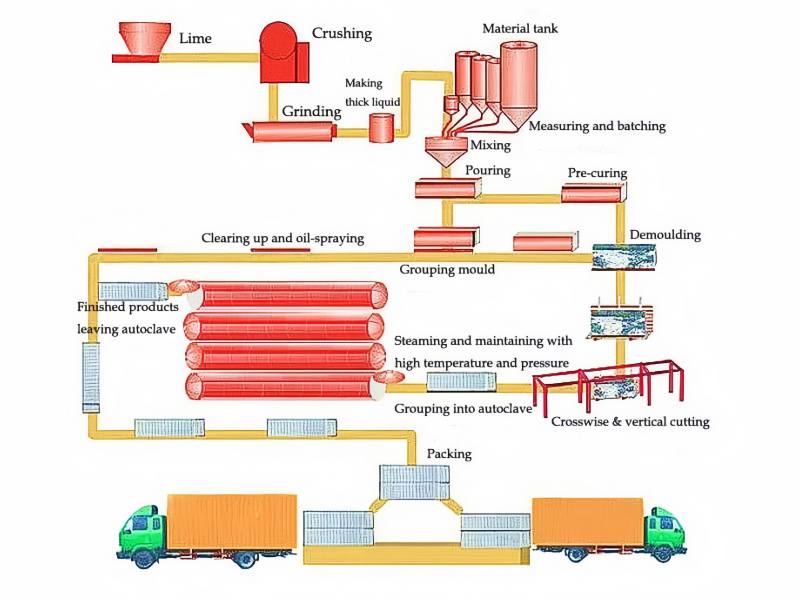
1. Raw Material Processing: Sand is crushed and ground to the desired fineness. Cement, lime, and gypsum are stored in silos, and aluminum powder is mixed with water to form an aluminum slurry.
2. Batching and Mixing: The various raw materials are weighed according to precise proportions and then thoroughly mixed in a mixer to form a uniform slurry.
3. Pouring: The mixed slurry is poured into steel molds. The size and shape of the molds can be designed to meet the desired block specifications.
4. Static Pre-curing: The molds containing the slurry are transported to a pre-curing area where the slurry gradually hardens under suitable temperature and humidity conditions to achieve initial strength. This process typically takes several hours.
5. Cutting: After the slurry is pre-cured, it is cut into the desired size and shape using high-precision cutting equipment like steel wire or blades.
6. Autoclave Curing: Blocks are placed in an autoclave and cured for several hours at temperatures of 175-200°C and pressures of 10-15 bar, significantly enhancing the blocks’ strength and durability.
7. Finished Product Processing: After autoclave curing, the blocks are removed from the autoclave and transported to a storage area. After inspection and packaging, they are ready for shipment.
Raw Materials of AAC block
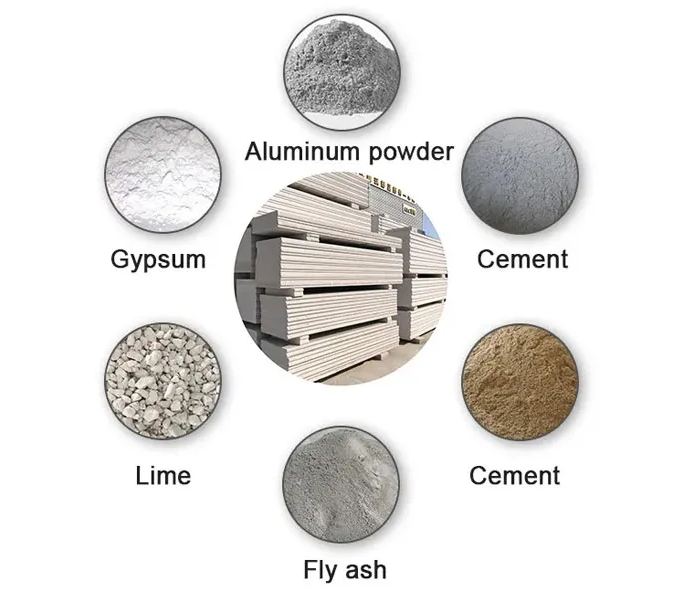
- Cement (Portland Cement): Acts as a primary binder, providing strength and durability to the blocks. Typically, 43 or 53-grade OPC is used.
- Fly Ash or Sand: Serves as the main siliceous material. Fly ash, a byproduct of coal-fired power plants, is an eco-friendly alternative to sand, providing the necessary silica content.
- Lime: A key calcareous material that reacts with other components to form the binding matrix and contributes to the chemical reactions during production.
- Gypsum: Added in small quantities to regulate the setting time and improve the workability of the mix.
- Aluminum Powder or Paste: Functions as a foaming agent. It reacts with lime and water to produce hydrogen gas, creating the characteristic porous, lightweight structure.
- Water: Essential for the hydration of cement and lime, and to facilitate the chemical reactions necessary for the setting and hardening of the blocks.
These materials are carefully proportioned and mixed to form a slurry, which is then cast, pre-cured, cut, and finally autoclaved to produce the finished AAC blocks.
Main Equipment in 300,000 m3/Year AAC Block Line
1. Jaw Crusher
Function: Crushes large lumps of raw materials such as limestone and gypsum into 50-150 mm pieces, facilitating subsequent fine grinding. It is a key piece of equipment for raw material pretreatment.
Structure: A fixed jaw plate and a movable jaw plate form a deep-chamber crushing chamber lined with impact-resistant, replaceable high-manganese steel tooth plates.
Capacity Range: Common models range from 100 to 500 t/h. The motor and main unit are integrated on a steel frame base, occupying only 4-6 m² of floor space.
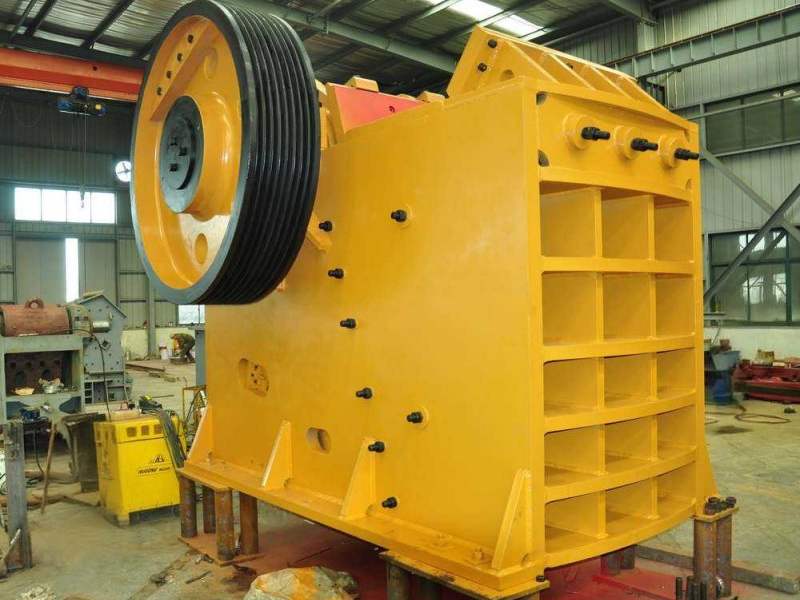
2. Ball Mill
Function: Grinds crushed lime, sand, or fly ash into a fine powder with a mesh size of 80-400 (0.2-0.045 mm) to enhance reactivity.
Structure: Horizontal cylinder+wear-resistant liner+steel ball media. It driven by a motor, reducer, and large gear.
Key Parameters: Cylinder diameter 1.2-2.4 m, ball load 5-30 t, power 55-800 kW.
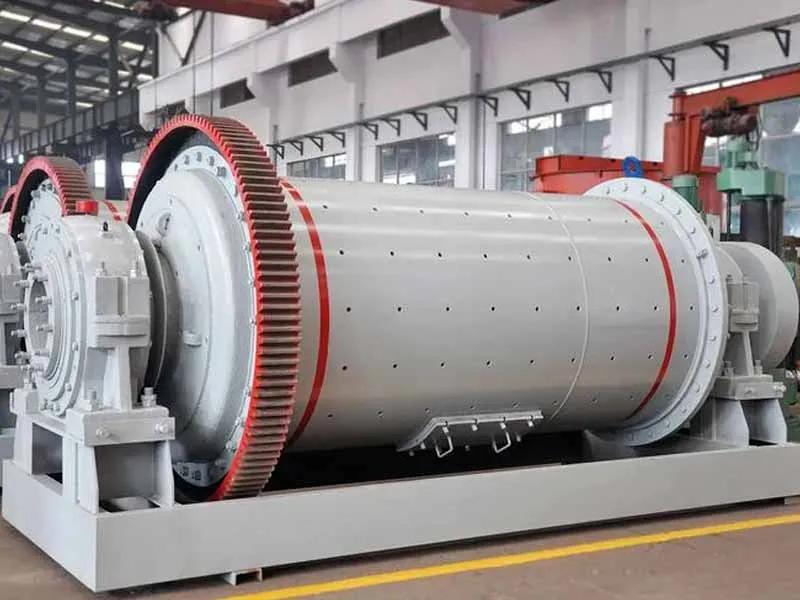
3. Batching System
Function: Accurately weighs cement, lime, fly ash, aluminum powder, and water according to the recipe, with an error of ≤ ±0.5%. Equipped with multiple silos, metering, and conveying equipment.
Module components: Electronic scale, screw feeder, pneumatic butterfly valve, PLC touch screen; one-touch recipe call, batching completed within 30 seconds.
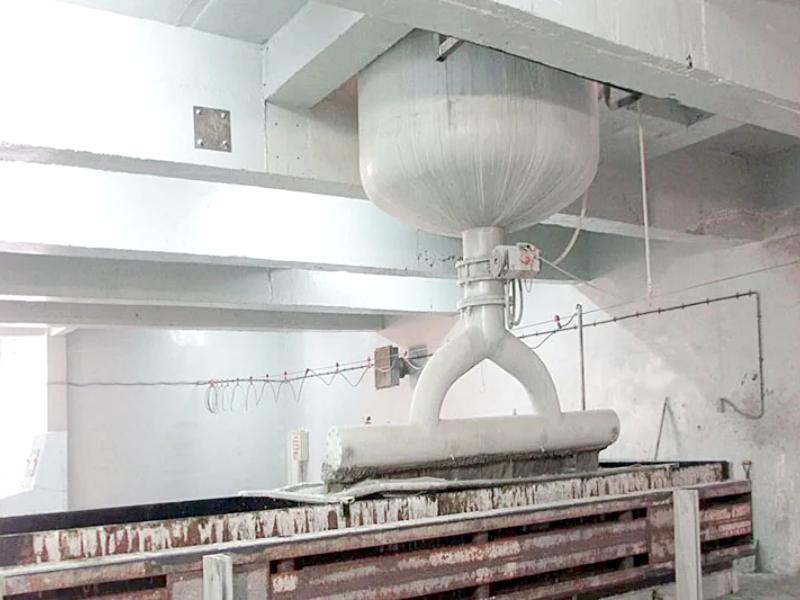
4. Mixing & Casting Machine
Function: Rapidly mixes weighed dry materials with water and aluminum powder into a fluid slurry, which is then poured into a mold for foaming.
Features: Twin-shaft forced mixing completes one batch in 60-90 seconds; hydraulically tilts 90° for drip-free pouring.
Key Parameters: Effective volume 2-4 m³, motor power 37-55 kW, removable mixing blades, wear life ≥ 30,000 cycles.
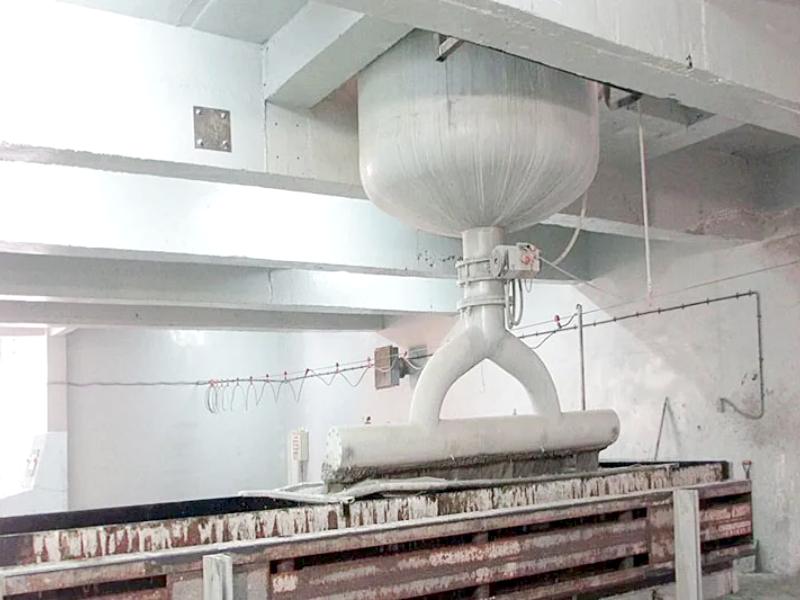
5. Tilting Cutter
Function: Cuts pre-cured billets into desired specifications with an accuracy of ±1 mm. Offcuts are recycled online.
Structure: Three sets of longitudinal, transverse, and horizontal steel wire frames; servo motors synchronize lifting and lowering, automatically compensating for wire wear.
Capacity: Cutting cycle ≤ 5 minutes/die; can cut 75-300 mm thickness, 600 mm standard length, or 1200 mm slabs.
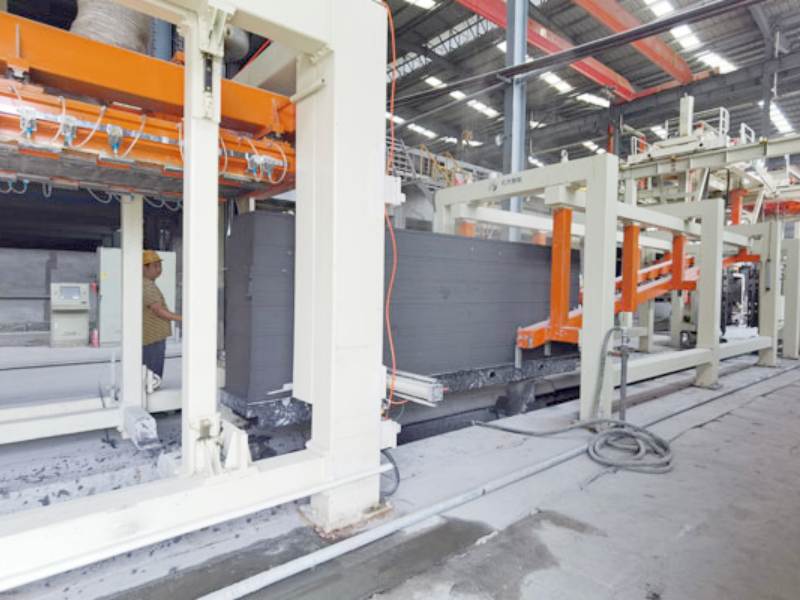
6. Autoclave
Function: High-temperature, high-pressure steam curing allows the green body to complete the hydrothermal synthesis reaction within 8 hours, increasing its strength by 5-8 times.
Specifications: Φ2.68×32 m or Φ2.85×38 m; design pressure 1.6 MPa, operating temperature 200°C; equipped with safety interlock and automatic blowdown.
Configuration: Each medium-sized line is equipped with 4-8 units, which can be connected in series or parallel. Energy-saving models include a waste heat recovery interface.

7. PLC Control Room
Function: Serves as the control center for the entire production line, offering features such as recipe management, parameter adjustment, process monitoring, energy consumption analysis, fault alarms, and remote app viewing.
Hardware: Reserved OPC UA interface for integration with the factory’s MES/ERP system.

8. Waste Gas Heat Recovery System
Principle: Autoclave exhaust gas at 160°C is preheated to 90°C via a heat exchanger, saving 8–12% of natural gas annually.
Configuration: Plate heat exchanger+circulation pump+automatic temperature control valve.

Main Parameters of 300,000 m³ AAC Block Plant
| Category | Parameters | Details |
| Capacity & Production | Annual Design Capacity | 300,000 m³ |
| Daily Production Capacity (Working Days: 300/Year) | About 1,000 m³/day | |
| Production Shift | 2-3 shifts/day (8 hours/shift, configurable based on demand) | |
| Raw Material Consumption | Siliceous Material (Fly Ash/Sand/Slag) | 1,200-1,400 kg/m³ (e.g., 360,000-420,000 tons/year for fly ash) |
| Calcareous Material (Cement/Lime) | 300-350 kg/m³ (e.g., 90,000-105,000 tons/year for cement + lime) | |
| Aerating Agent (Aluminum Powder/Paste) | 0.5-0.8 kg/m³ (e.g., 150-240 tons/year) | |
| Water Consumption | 400-500 kg/m³ (recyclable water accounts for 30%-40%) | |
| Key Equipment Specs | Raw Material Batching System | Capacity: 50-80 m³/h; Batching accuracy: ±0.5% |
| Mixing-Pouring Machine | Mixing capacity: 30-50 m³/h; Pouring accuracy: ±1% | |
| CNC Cutting Machine | Cutting size range: based on your need Error: ±1mm | |
| Autoclave | Quantity: 6-8 units; Single volume: 150-200 m³; Working pressure: 1.2 MPa; Working temperature: 200℃ | |
| Automatic Conveying System | Speed: 0.5-1 m/s; Load capacity: 5-10 tons/section | |
| Finished Product Index | Dry Density of AAC Blocks | 400-800 kg/m³ (meets GB/T 11968-2020 Class A/B standards) |
| Compressive Strength | ≥3.5 MPa (for 600 kg/m³ density, suitable for non-load-bearing walls) | |
| Thermal Conductivity (Dry State) | 0.10-0.20 W/(m·K) | |
| Sound Insulation (Airborne Sound) | ≥40 dB (for 200 mm thick blocks) | |
| Energy & Environmental | Power Consumption | ~80-100 kWh/m³ (total for production line) |
| Steam Consumption | ~300-350 kg/m³ (from natural gas/coal-fired boiler, ≥90% thermal efficiency) | |
| Industrial Solid Waste Utilization Rate | ≥70% (using fly ash/slag as main raw materials) | |
| Waste Gas Emission | NOₓ ≤50 mg/m³, SO₂ ≤35 mg/m³ (meets national ultra-low emission standards) | |
| Automation Level | Control System | PLC + HMI (human-machine interface), real-time production monitoring |
| Automated Processes | Raw material batching, mixing-pouring, cutting, autoclave control, packaging (100% automated) | |
| Site Requirement | Total Land Area | ~15,000-20,000 ㎡ (including production workshop, raw material warehouse, finished product yard) |
| Workshop Height | ≥8 m (for autoclave and crane operation) |
What Is An AAC Block?
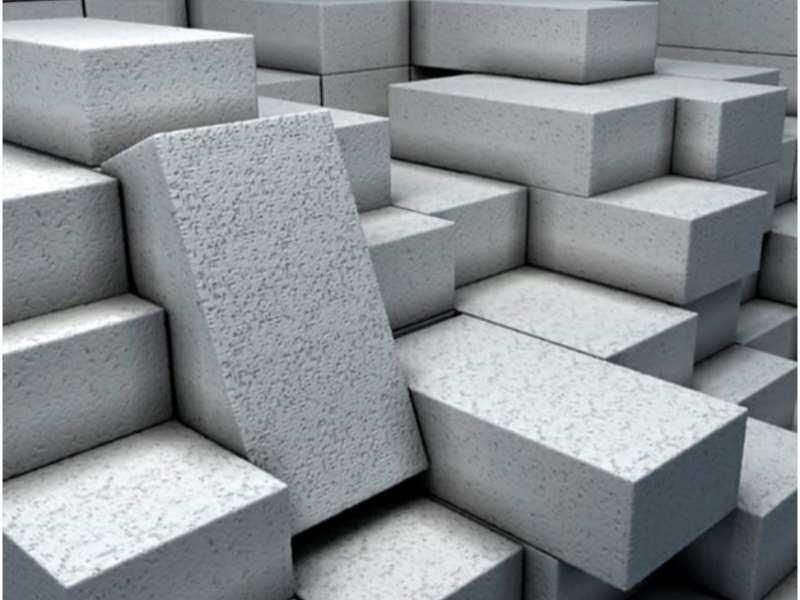
Autoclaved aerated concrete (AAC) blocks are a lightweight, porous, high-strength new building material.
The unique internal pore structure provides lightweight, high strength, thermal insulation, fire resistance, and sound insulation.
It is an ideal choice for achieving energy-saving and structural safety in buildings.
Why Choose Us?
Investing in a 300,000 m³/Year AAC Block Manufacturing Plant is a big decision, and we’re here to make sure your investment pays off. Here’s what you get when you work with us:
1. Turnkey Solution:
We offer full turnkey service, from plant design, equipment manufacturing, to installation, commissioning, and staff training. Our engineers have over 15 years of AAC plant experience, so we’ll build the plant exactly as you need, and make sure it meets local rules.
2. After-Sales Support:
We’re here for you 24/7 with after-sales service, including:
- Regular maintenance checks (on-site or online).
- Fast spare parts supply (we keep lots of parts in key areas).
- Technical training for your operators and maintenance team (in-person or online).
3. Customization Options:
We know every customer has different needs. Whether you want to adjust the plant’s capacity, add special equipment (like a waste water recycling system), or adapt to local raw materials, we can customize the plant to fit you.
4. Proven Track Record:
We’ve supplied AAC block plants to over 50 countries (e.g., India, Indonesia, Nigeria, Brazil). Our 300,000 m³/Year AAC Block Plant works well in many projects, and customers say it hits or exceeds the annual capacity target 95% of the time.
Services We Offer
- Project Planning & Design
Provide overall planning and detailed design schemes for AAC block plants based on client needs and actual conditions, including process design, equipment layout, and civil engineering design. - Equipment Supply & Installation
Supply full sets of AAC production line equipment, and undertake installation and commissioning to ensure normal operation, meeting designed capacity and product quality standards. - Technical Training
Offer professional training for operators, technicians, and managers covering production processes, equipment operation, maintenance, and quality management. - After-Sales Service
Establish a sound after-sales system providing daily maintenance guidance, fault troubleshooting, and spare parts supply to ensure continuous stable production. - Technical Support & Upgrades
Provide ongoing technical support and offer equipment upgrading/technical transformation solutions based on client needs and industry trends to improve efficiency and quality. - EPC General Contracting
One-stop EPC services from design, equipment procurement, civil construction, installation, and training to trial production for a hassle-free experience.
Other Hot-sale Block Manufacturing Plant
| Annual Production | Price (USD) | Core Configuration |
|---|---|---|
| 100,000 m³ | 1.5–1.9 M | Air-turning cutting, 3×31 m autoclaves |
| 150,000 m³ | 2.1–2.6 M | Robotic palletizing, 4×31 m autoclaves |
| 200,000 m³ | 2.8–3.5 M | Six-sided cutting, 4×37 m autoclaves |
| 300,000 m³ | 1.5–4.8 M | Dual cutting lines, 6×37 m autoclaves |
| 400,000 m³ | 4.5–6.5 M | Fully automatic air-turning, 8×37 m and above autoclaves |
